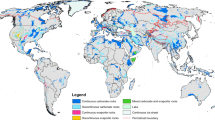Abstract
Modern and Pleistocene polar carbonates occur in East Antarctica in shelf, coast, lakes and marginal to underneath glaciers, associated mainly with glacigene muds, boulder tills and diamictites. Shelf carbonates (in Prydz Bay) are calcitic and unlithified, and consist mainly of sponges, bryozoans, echinoderms, bivalves and diatoms. Coastal carbonates (in the Vestfold Hills) are calcitic and contain faunal assemblages similar to those on the shelf, with calcareous algae, microbial mats, minor peloids and cements. Lake carbonates are aragonitic micrites and peloids. Carbonates close to glaciers (the Løken Moraines) are aragonitic and contain abundant ooids with intragranular fibrous cements. Subglacial carbonates are aragonitic micrites and peloids. Carbonate mineralogy changes from mainly low-Mg calcite in marine shelf to aragonite in brackish to freshwater dominated inland regions.
Antarctic carbonate δ18O values (4.5 to −47‰ PDB) vary markedly due to frigid temperatures (0 to −2°C) and salinity (0 to 35‰) changes, as a result of meltwater dilution from adjacent glaciers. Their δ13C values (−9 to 8‰ PDB) also vary markedly due to exposure to atmospheric CO2, the circulation of water masses and reaction of carbonate with CO2 trapped in glacial ice.
The regional distribution of carbonate sediments and their sedimentology, mineralogy, and δ18O and δ13C compositions indicate three types of glacial environments of formation. The first corresponds to a glacial stage and the formation of subglacial and bank carbonates, when the Antarctic ice sheet expanded onto the inner shelves. The second corresponds to interglacial stages and the formation of ice-marginal carbonates, during the retreat of the ice sheet from the inner shelf grounding line and accompanying the discharge of appreciable meltwater. The third corresponds to an interglacial oasis and the formation of coastal carbonates, proximal to distal lacustrine carbonates, and distal subglacial carbonates.
Similar content being viewed by others
References
AHARON, P., 1988, Oxygen, carbon and U-series isotopes of aragonites from Vestfold Hills, Antarctica: Clues to geochemical processes in subglacial environments:Geochimica et Cosmochimica Acta, v. 52, p. 2321–2331.
ALEXANDERSSON, E.T., 1978, Destructive diagnesis of carbonate sediments in the eastern Skagverrak, North Sea:Geology, v. 6, p. 324–327.
ANDERSON, T.F. and ARTHUR, M.A., 1983, Stable isotopes of oxygen and carbon and their application to sedimentologic and environmental problems, in Stable Isotopes in Sedimentary Geology, edited by M.A. Arthur and T.F. Anderson, Society of Economic Paleontologists and Mineralogist, Tulsa, Oklahoma, p. 1–151.
ANDERSON, J.B. and ASHLEY, G.M., 1991, Glacial Marine Sedimentation; Paleoclimatic significance. Geological Society of America, Inc., 232 p.
BARDIN, V.I., PISKUN, A.A., and SHMIDBERG, N.A., 1990, Hydrological and hydrochemical characteristics of deep water basins in Prince Charles Mountains: Antarktika, doklady komissii, No. 29, p. 97–112
BIRD, M.I., CHIVAS, A.R., RADNELL, C.J., and BURTON, H.R., 1991, Sedimentological and stable-isotope evolution of lakes in the Vestfold Hills, Antarctica:Paleogeography, Paleoclimatology, Palaeoecology, v. 84, p. 109–130.
BJAERKE, T. and DYPVIK, H., 1977, Quaternary “stromatolitic” limestone of subglacial origin from Scandinavia:Journal of Sedimentary Petrology, v. 47, p. 1321–1327.
BURTON, E.A. and WALTER, L.K., 1991, The effects of PCO2 and temperature on magnesium incorporation in calcite in seawater and MgCl2−CaCl2 solutions:Geochimica et Cosmochimica Acta, v. 55, p. 777–785.
CHAVE, K.E., 1954, Aspects of the biogeochemistry of magnesium 2. Calcareous sediments and rocks:Journal of Geology, v. 62, p. 587–599.
CRAIG, H., 1965, The measurement of oxygen isotope paleotemperatures,in Stable isotopes in Oceanographic Studies and Paleotemperatures: Spoleto, July 26–27, 1965, Consiglio Nazionale delle Richerche, Laboratorio di Geologia Nucleare, Pisa, p. 1–124.
DOMACK, E.W., 1988, Biogenic facies in the Antarctic glacimarine environment: Basis for a polar glacimarine summary:Paleogeography Palaeoclimatology Palaeoecology, v. 63, p. 353–372.
FERRIS, J.M. and BURTON, H.R., 1988, Annual cycle of heat content and mechanical stability of hypersaline deep lake, Vestfold Hills, Antarctica:Hydrobiologia, v. 165, p. 115–128.
FRANKLIN, D.C., 1993, Recent diatom and foraminiferal assemblages in surficial sediments of Prydz Bay, Antarctica: Australian National Antarctic Research Expedition Research Notes, v. 90, 27 p.
FREIWALD, A., 1993, Coralline algal maerl frameworks — islands within the phaeophytic kelp belt:Facies, v. 29, p. 133–148.
FRIEWALD, A. and HENRICH, R., 1994, Reefal coralline algal build-ups within the Arctic Circle: morphology and sedimentary dynamics under extreme environmental seasonality:Sedimentology, v. 41, p. 963–984.
GOODWIN, I.D., 1993, Holocene deglaciation, sea-level change and the emergence of the Windmill Islands, Budd Coast, Antarctica:Quaternary Research, v. 40, p. 70–80.
GOODWIN, I.D., 1996, A mid to late Holocene readvance of the Law Dome ice margin, Budd Coast, East Antarctica:Antarctic Science, v. 8, p. 395–406.
GORE, D.B., CREAGH, D.C., BURGESS, J.S., COLHOUN, E.A., SPATE, A.P., and BAIRD, A.S., 1996, Composition, distribution and origin of surficial salts in the Vestfold Hills, east Antarctica:Antarctic Science, v. 8, p. 73–84.
HALLET, B., 1976, Deposits formed by subglacial precipitation of CaCO3:Geological Society of America Bulletin, v. 87, p. 1003–1015.
HANSHAW, B.B. and HALLET, B., 1978, Oxygen isotope composition of subglacially precipitate calcite: possible paleoclimate implications:Science, v. 200, p. 1267–1270.
HAMBREY, M., 1995, Glacial Environments, UCL press, London, 296 p.
HARRIS, P.T., O’BRIEN, P.E., SEDWICK, P. and TRUSWELL, E.M., 1996, Late Quaternary history of sedimentation on the Mac. Robertson Shelf, East Antarctica: problems with14C-dating of marine sediment core:Papers and Proceedings Royal Society of Tasmnia, v. 130, p. 47–53.
HENDY, C.H., HEALY, T.R., RYNER, E.M., SHAW, J., and WILSON, A.T., 1979, Late Pleistocene glacial chronology of the Taylor Valley, Antarctica, and the global climate:Quaternary Research, v. 11, p. 172–184.
JACOBS, S.S., FAIRBANKS, R.G., and HUBBERTEN, H.W., 1995, Origin and evolution of water masses near the Antarctic continental margin: Evidence from H2 18O/H2 16O ratios in seawater:Antarctic Research Series, v. 43, p. 59–86.
KINSMAN, D.J.J. and HOLLAND, H.D., 1969, The coprecipitation of the cations with CaCO3-IV. The coprecipitation of Sr2+ with aragonite between 16° and 96°C:Geochemica et Cosmochimica Acta, v. 33, p. 1–17.
KROOPNICK, P.M., 1985, The distribution of13C of CO2 in the world oceans:Deep Sea Research, v. 32, p. 57–84.
LEMMENS, M., LORRAIN, R., and HAREN, J., 1982, Isotopic composition of ice and subglacially precipitated calcite in an alpine area:Zeischrift fur Gletscherkunde und Glazialgeologie, v. 18, p. 151–159.
LEES, A., 1975, Possible influence of salinity and temperature on modern shelf carbonate sedimentation:Marine Geology, v. 19, p. 159–198.
LEUENBERGER, M., SIEGENTHALER, U., and LANGWAY, C.C., 1992, Carbon isotope composition of atmospheric CO2 during the last ice age from an Antarctic ice core:Nature, v. 357, p. 488–490.
LOWENSTAM, H.A., 1954, Factors affecting the aragonite calcite ratios in carbonate secreting marine organisms:Journal of Geology, v. 62, p. 284–322.
MARINO, B.D., McELROY, M.B., SALAWITCH, R.J., and SPAULDING, W.G., 1992, Glacial-to-interglacial variations in the carbon isotopic composition of atmospheric CO2:Nature, v. 357, p. 461–466.
MATSUBAYA, O., SAKAI, H., TORIL, T., BURTON, H., and KERRY, K., 1979, Antarctic saline lakes — stable isotopic ratios, chemical composition and evolution:Geochimica et Cosmochimica Acta, v. 43, p. 7–25.
MORGAN, V.I., 1982, Antarctic ice sheet surface oxygen isotope values:Journal of Glaciology, v. 28, p. 315–323.
MORSE, J.W. and MacKENZIE, F.T., 1990, Geochemistry of Sedimentary Carbonates. Developments in Sedimentology 48, Elsevier, 707 p.
MUCCI, A., 1987, Influence of temperature on the composition of magnesian calcite overgrowths precipitated from seawater:Geochimica et Cosmochimica Atca, v. 51, p. 1977–1984.
PETERSON, J.A. and MORESBY, J.F., 1979, Subglacial travertine and associated deposits in the Carstensz area, Irian Jaya, Republic of Indonesia:Zeitschrift fur Glescherkunde and Glazialgeologie, v. 15, p. 23–29.
PETERSON, J.A., FINLAYSON, B.L., and ZHANG, Q., 1988, Changing distribution of late Quaternary terrestrial lacustrine and littoral environments in the Vestfold Hills, Antarctica:Hydrobiologia, v. 165, p. 221–226.
McCONNAUGHEY, T., 1989;13C and18O isotopic disequilibrium in biological carbonates. I. Patterns:Geochimica et Cosmochimica Atca, v. 53, p. 151–162.
PICKARD, J., 1984, The Holocene fossil marine macrofauna of the Vestfold Hills, East Antarctica.Boreas, v. 14, p. 189–202.
PICKARD, J., ADAMSON, D., HARWOOD, D.M., MILLER, G.H., QUILTY, P.G., and DELL, R.K., 1984, Early Pliocene marine sediments in the Vestfold Hills, East Antarctica: Implication for coastline, ice sheet, and climate:South African Journal of Science, v. 82, p. 520–521.
RAO, C.P., 1981, Criteria for recognition of cold-water carbonate sedimentation: Berriedale Limestone (Lower Permian), Tasmania, Australia:Journal of Sedimentary Petrology, v. 51, p. 491–506.
RAO, C.P., 1983, Cold-water spherical grains from a fresh-water drainage pipe, Gordon Dam, Tasmania, Australia:Journal of Sedimentary Petrology, v. 53, p. 1169–1173.
RAO, C.P., 1988, Oxygen and carbon isotope composition of cold-water Berriedale Limestone (Lower Permian), Tasmania, Australia:Sedimentary Geology, v. 60, p. 221–231.
RAO, C.P., 1993, Carbonate minerals, oxygen and carbon isotopes in modern temperate bryozoa, eastern Tasmania, Australia:Sedimentary Geology, v. 88, p. 123–135.
RAO, C.P., 1996, Modern Carbonates: tropical, temperate and polar_ — introduction to sedimentology and geochemistry, Carbonates, Hobart, 206 p.
RAO, C.P. and GREEN, D.C., 1982, Oxygen and carbon isotopes of Early Permian cold-water carbonates, Tasmania, Australia:Journal of Sedimentary Petrology, v. 52, p. 1111–1125.
RAO, C.P., AMINI, Z.Z., and FRANKLIN, D., 1995, Grain-size, biota, sedimentology and oxygen and carbon isotopes of sediments, Davies Station and Prydz Bay, Antarctica: evidence for occurrence and recession of shelf ice:ANARE Res. News, v. 94, p. 33–34.
RAO, C.P., AMINI, Z.Z., and FRANKLIN, D., 1996, Comparison between modern polar and temperate skeletal carbonate mineralogy and oxygen and carbon isotopes, Antarctica and Tasmania shelves.In Banks, M.R. and Brown, M.J, eds., Climatic succession and glacial history of the southern hemisphere over the last five million years:Papers and Proceedings of Royal Society of Tasmania, v. 130, p. 87–93.
RUBINSON, H. and CLAYTON, R.N., 1969, Carbon-13 fractionation between aragonite and calcite:Geochimica et Cosmochimica Atca, v. 33, p. 997–1004.
SMITH, N.R., DONG, Z., KERRY, K.R., and WRIGHT, S., 1984, Water masses and circulation in the region of Prydz Bay, Antarctica:Deep Sea Research, v. 31, p. 1121–1147.
TARUTANI, T., CLAYTON, R.N., and MAYEDA, T.K., 1969, The effect of polymorphism and magnesium substitution on oxygen isotope fractionation between calcium carbonate and water:Geochimica et Cosmochimica Acta, v. 46, p. 987–996.
TAVIANI, M., REID, D.E., and ANDERSON, J.B., 1993, Skeleltal and isotopic composition and paleoclimatic significance of late Pleistocene carbonates, Ross Sea, Antarctica:Journal Sedimentary Petrology, v. 63, p. 84–90.
Author information
Authors and Affiliations
Rights and permissions
About this article
Cite this article
Rao, C.P., Goodwin, I.D. & Gibson, J.A.E. Shelf, coastal and subglacial polar carbonates, East Antarctica. Carbonates Evaporites 13, 174–188 (1998). https://doi.org/10.1007/BF03176591
Received:
Accepted:
Published:
Issue Date:
DOI: https://doi.org/10.1007/BF03176591




